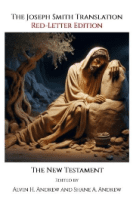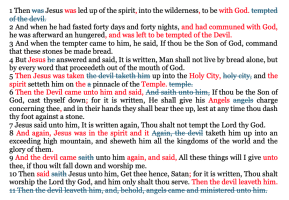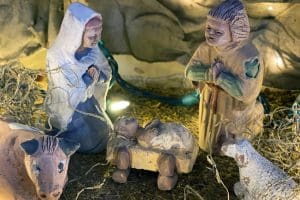In the King James Version (KJV) of the Bible, the verses dealing with Jesus’ baptism generally focus on the testimony of John the Baptist. Few verses describe the Lord’s actual baptism in the KJV or the Joseph Smith Translation (JST). However, the JST significantly enhances the testimony of John the Baptist regarding the Savior and his mission. 
The chapter numbering and textual highlighting reflect the JST. Red print highlights the JST alterations and blue print with a strike-through shows how the KJV read previously. This can be easily followed in The Joseph Smith Translation, Red-Letter Edition, New Testament in this and coming articles. The complete JST changes are available in an eBook or book version at https://jstrle.com1.
Each of the four Gospels provide their own view of John’s testimony and mission. All four gospels quote John saying that he was the “voice of one crying in the wilderness” referencing the prophecy of Esaias (Isaiah 4:3). Each of the Gospels also explain that John’s mission was to “Prepare ye the way of the Lord, and make his paths strait. straight (Matthew 3:29).”
This phrase in Matthew, however, is the only instance in the Gospels where Joseph Smith made the word change from straight to strait, thus altering the emphasis of the mission of John the Baptist2.
It is in Luke where we see the Prophet Joseph make the most significant addition to the Baptist’s testimony of Christ when he declares:
Luke 3:4-113


As we can see from the JST, John the Baptist’s testimony was far more insightful and doctrinally aware than the KJV portrayal. It is significant here that John testifies that the Savior’s mission included “to take away the sins of the world”, making salvation available to the “heathen nations”, gathering together the lost “sheepfold of Israel” and making “possible the preaching of the gospel unto the Gentiles.”; this latter teaching would not have set well with the Jewish doctors and leaders. The concept of “resurrection from the dead”, would have stirred the ire of the Sadducees as well considering their unbelief in that principle. 
Whether or not the JST additions are the original text of Luke is not known. The Prophet Joseph Smith certainly had the authority and was capable of providing an enhanced version of the testimony of the Lord’s “…witness, to bear witness of the light, Light, to bear record of the gospel through the son, unto all, that all men through him men might believe. (John 1:7). The Apostle John speaks of the mission of John the Baptist as well, but with greater detail and emphasis on the mission of Christ, the context of which we discuss in a follow up article.
The Baptist then proceeded to warn the people and in particular the Pharisees and Sadducees, the ruling elite among the people of Israel.
Matthew 3:33-37

In these verses the Baptist declares a clear admonition to those who do not receive his words, chiding them further that they would not receive the words of Christ either. John continues anddispels the false teachings of the Pharisees and Sadducees about them being the offspring of Abraham, and the only recipients of the promises made by God to their father Abraham.
In Luke’s account, the Baptist is then questioned by those who came to hear him and be baptized when they asked “Master, what shall we do?”. Though most of the story remains the same in the JST as in the KJV, the JST does insert a more detailed explanation about Publicans.
Luke 3:17-20

All the Gospels then briefly describe the Savior coming to John and being baptized. JST Matthew adds the most significant additions of Christ’s baptism when it says:
Matthew 3:40-44

Following Christ’s baptism all four Gospels relate John’s witness of the Spirit alighting upon Christ in the form of a dove and the voice of God the Father declaring that Jesus was “…my beloved Son, in whom I am well pleased. And John bare record of it.” (Mark 1:11).
Following his baptism Christ was led by the spirit into the wilderness. This event is recorded in Matthew, Mark, and Luke, but John makes no mention of it. Mark barely refers to it with only two verses. Matthew and Luke have the most complete and similar description of the event. We will use the record of Matthew to tell the story.
Matthew 4:1-10

JST Matthew makes a significant change in the purpose for which the Savior went into the wilderness. JST Luke tells the same story. He went “to be with God. And when he had fasted forty days and forty nights, and had communed with God, he was afterward an hungered, and was left to be tempted of the Devil.”
The JST makes it very clear that the Savior’s purpose in going into the wilderness was to be with and commune with his Father. Only then was he “left to be tempted of the devil”. On the very eve of the beginning of his ministry it makes perfect sense that Christ would commune with his Father, discussing the events that would transpire over the following three years, culminating in the atonement and resurrection. Also important was the Savior’s need to experience the vicissitudes of mortal life, including the temptations of Satan, in order that he might perfectly succor Father’s children. Obviously, he did not succumb to the devil’s temptations, but he experienced Satan’s best efforts none-the-less.
Another item the JST clarifies is that it was while he was “in the spirit” that Jesus was taken upon “the pinnacle of the Temple” and “up into an exceeding high mountain”. While the devil did indeed come to him in those places with temptations commensurate with Christ’s visions, Satan did not transport the Savior anywhere. The Savior was taken to those places in or by the spirit and for his own reasons.
The Savior’s baptism and wilderness sojourn are clarified and made more understandable by the JST. This marvelous work by the Prophet Joseph Smith once again lifts and expands our understanding of the mission and life of our Savior, Jesus Christ.
Footnotes
1. These publications can be obtained from resellers such as Amazon, Barnes & Noble or eBay. However, they are much less expensive from this website.
2. In his book A Plainer Translation, The Joseph Smith Translation, A History and Commentary, Robert J. Matthews postulates that even though the JST was officially complete, Joseph continued to modify and alter the text up until his death in July 1844. Matthews refers to several of Joseph’s sermons after the stated completion of the JST in July 1833, wherein Joseph renders verses differently than they are quoted in the KJV, but those revisions do not appear in the JST. This may explain in part why in several instances in the JST a change was made in one book but not made in a different book when the same event is described. In that sense it seems that the JST was not as refined or as complete as Joseph wished it to be before it went to press.
3. Joseph Smith significantly altered the sequence of verses in Matthew Chapters 2 & 3 as well as the contents of those two chapters. Red text identifies the JST alterations even regarding chapter numbers and verses, while blue text with a strike-through identifies the KJV text, verse, or chapter as it read originally. Black text is untouched KJV text, and chapter or verse numbering. While it is true that the JST manuscript often did not follow KJV verse numbering, it did break the text into chapters and sometimes verses.




















